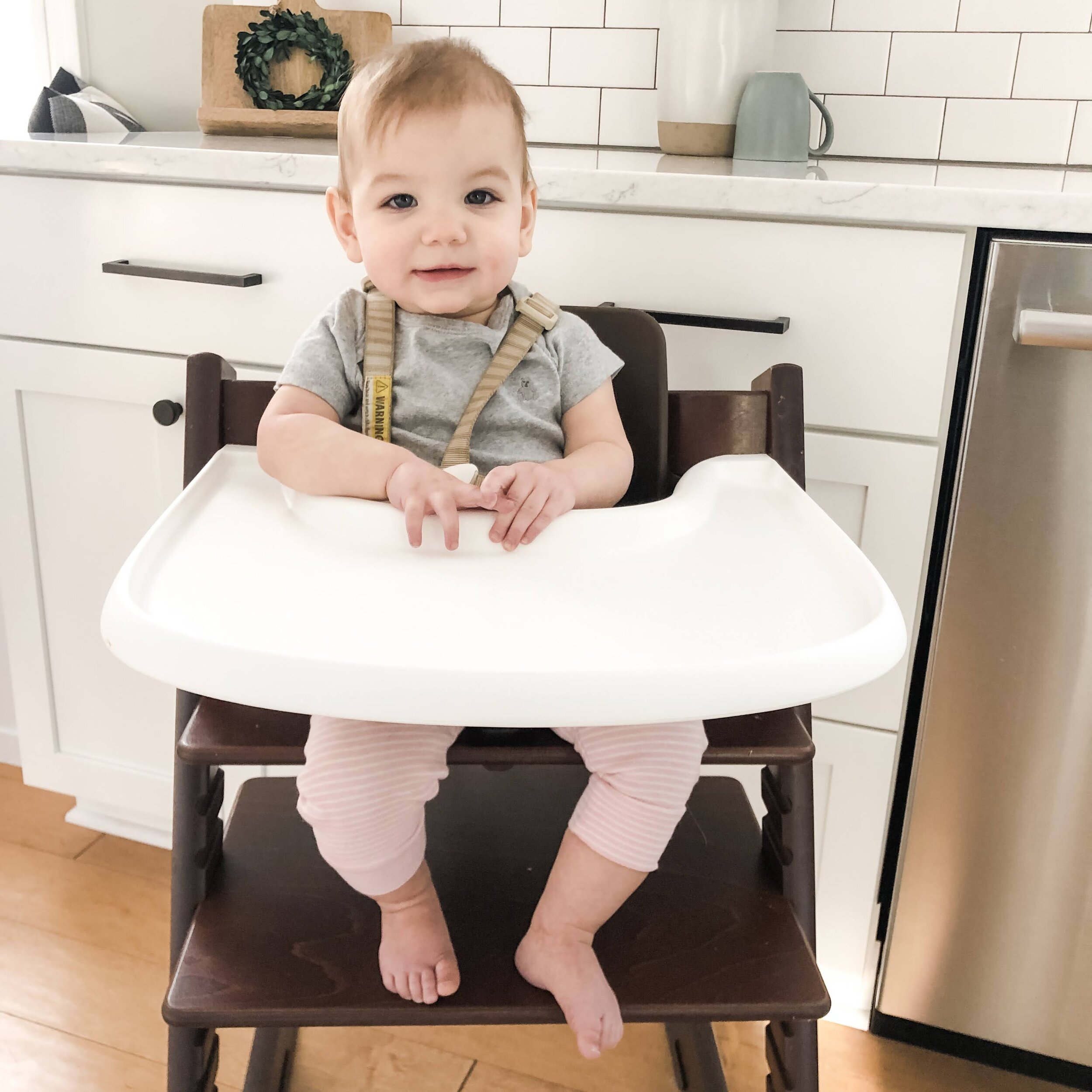Once you’ve determined that your baby is ready to start eating solid foods, we strongly encourage you to take a few minutes to look at her positioning in the high chair. Baby’s body position in the chair sets up the foundation for a safe and comfortable feeding experience - for both of you. If baby feels safe and supported, she is more likely to dive into exploring the new foods you’re about to offer. Additionally, optimal support of the larger (core) muscles of the body in the chair, will allow for free movement of the smaller muscles of the hands, face and mouth for eating, chewing, and swallowing safely.
Your highchair should have:
Supportive seat: Her seat should be flat (not a rounded bucket seat where baby’s bum is lower than her knees) and should have support under the thighs, meaning baby should be supported by the seat from bum to knee. Baby should sit with an upright posture, not a hunched over or flopping forward posture. Her hips should bend at a 90 degree angle, knees should ideally bend at the edge of the seat and hang down at about a 90 degree angle, and ankles should bend at a 90 degree angle with feet supported (see below) This is the 90-90-90 rule I refer to later on.
Foot support: Feeding can be a new and overwhelming experience for some babies. Having her feet supported on a footrest will help your baby feel more grounded and ready to focus on eating. There is a neurological fight or flight response that can occur when our feet dangle and maintaining good posture becomes quite difficult without the ability to push through the feet. Think about it- you always have your feet on the floor while eating in a chair, barstool or in standing. Give your baby the same courtesy and support her feet!
If your high chair doesn’t have a footrest see if you can add one by tying a belt or other material around the legs of the chair to give the feet somewhere to land, try putting a box or storage tote under the chair to support baby’s feet, or pull your chair up close to face baby and let baby’s feet rest on your knees to achieve a 90 degree angle at the ankle. You can also try this one from Bapron Baby that clips on to most highchairs.
Although not ideal, if your highchair causes your baby to sit with legs straight out in front (knees aren’t bent) and feet are supported by the chair’s seat, that is typically better than dangling feet they can kick around.
*Bonus tip: If your baby is kicking his/her feet all over the place or becomes a bit overwhelmed during a feed, try giving gentle but firm pressure into the soles of the feet by gently squeezing. Hold for 5-10 seconds. Release. Repeat 3-5x before starting or offering more food. This is a way to neurologically calm and ground a baby who may be feeling overwhelmed (excited or anxious) about the feeding experience.
Tray height: Babies who are still mastering sitting will use their arms to support themselves if they wobble a bit. When sitting in the highchair, your baby may want or need to support her posture by placing arms on the tray at first. Moreover, we want baby to easily have access to items and food that is placed on the tray or table to encourage self feeding. Baby’s shoulders should rest comfortably with elbows and forearms on the tray at a ~90 degree angle. The tray should not be so high that baby’s shoulders are pushed upward when the arms rest on the tray. If baby’s shoulders are pushed up or look like they are being hiked up because of the tray height, try placing a towel under baby’s bottom and thighs to give her a little boost up. If you boost her, make sure to look at the feet again, you may need to add a towel roll there now too.
Strap position: For best postural support and safety, we recommend a highchair with a 5-point harness be used when feeding your baby. Straps should rest on the top of baby’s shoulder and fasten around the middle with a firm buckle. Keep in mind that straps for highchairs do not need to be as tight as they do in car seats. Baby should have enough room to comfortably raise his/her hands above the head or to reach out and grab foods from the tray or table for self-feeding but not loose enough for baby to wiggle free.
If you are in the market for a highchair, we do have a few top choices that we recommend our favorite high chairs post.
Now that you have your baby in a safe and ergonomic feeding position, it’s time to make a mess and explore new foods! Check out our post on When should my baby start solids? and our list of favorite feeding supplies from developmental feeding experts including utensils, high chairs, bibs and more.
We truly hope you enjoy your feeding journey. Don’t hesitate to reach out with any questions along the way, we’re here to help.
-Bree & Jaclyn
We’re Bree & Jaclyn
Pediatric therapists and moms with a mission to empower you with knowledge to encourage your baby’s development and continue confidently into your parenthood journey.
If you have any questions, please feel free to leave a comment below and we will get back to you. As always, the information we share is meant to provide general education and tips and is not intended as medical advice. If you have a specific question or concern about your child’s development, please speak directly to your child’s doctor or therapist.





